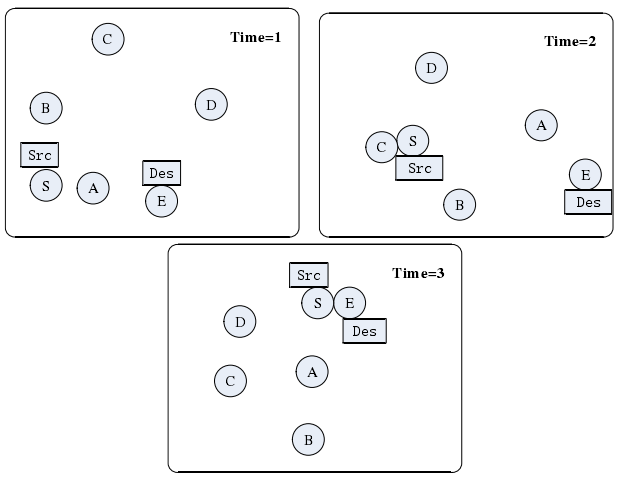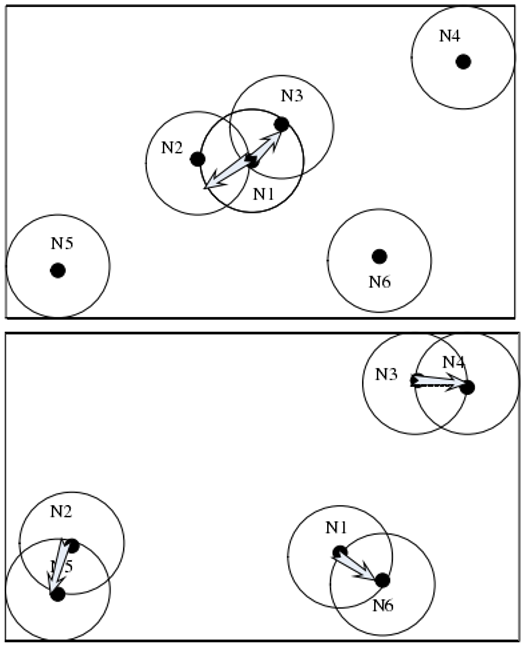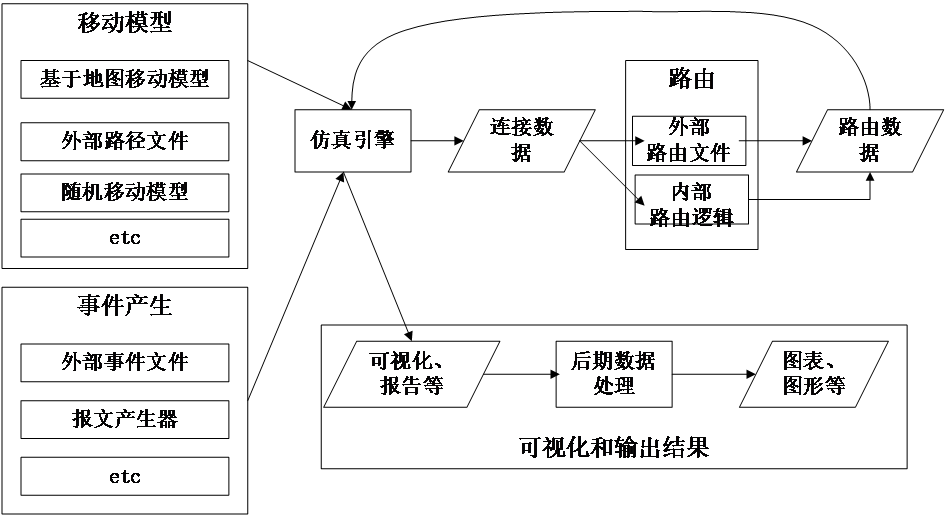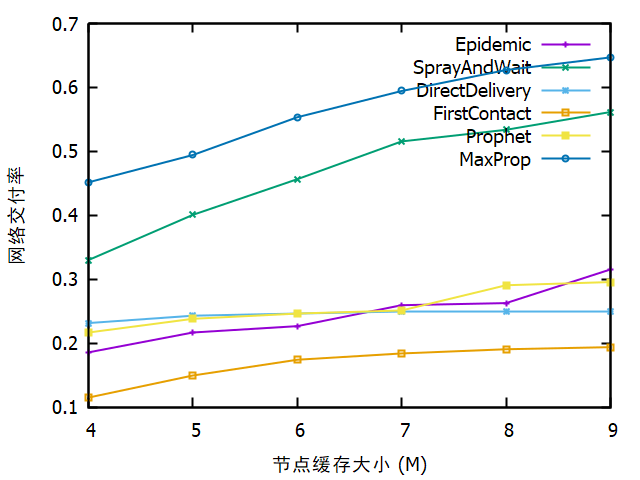车联网环境下DTN路由协议仿真分析毕业论文
2020-04-20 13:51:10
摘 要
由于车联网的环境与传统网络存在较大差异,导致车联网不会能直接在因特网上。为了解决该类问题,研究人员提出了延迟容忍网络(Delay Tolerant Network,DTN),路由协议的研究就成为DTN网络的重点。
本文通过对车联网环境的分析并结合对DTN网络的典型路由算法进行仿真分析,在其基础上针对车联网的特性提出了适用于车联网的DTN路由算法。通过对DTN网络的六种典型路由算法,First Contact算法、Direct delivery算法、Epidemic算法、Spray and Wait算法、Prophet算法、MaxProp算法,在节点缓存大小和节点数量,以及消息生存时间不同的情况下进行了大量的仿真实验,通过折线图展示仿真结果,并分析各个算法的优缺点。
通过分析车联网环境结合DTN路由算法的仿真结果分析,本文提出了一种基于Spray and Wait算法改进优化的新算法基于节点信息的喷射选择算法(Spray and Select Based on Nodes Information,SSNI)。SSNI算法引入了节点效用值,增大消息传递转发过程对目的节点的针对性,这使得网络交付率得到提升。
关键词:车联网 延迟容忍网络 路由协议 节点信息
Simulation Analysis of DTN Routing Protocol in Vehicle Network Environment
Abstract
Due to the large difference between the environment of the Internet of Vehicles and the traditional network, the Internet of Vehicles will not be directly on the Internet. In order to solve this kind of problem, the researchers proposed a delay tolerance network (DTN), and the research of routing protocols became the focus of the DTN network.
Based on the analysis of the Internet of Vehicle environment and the typical routing algorithm of DTN network, this paper proposes a DTN routing algorithm suitable for the Internet of Vehicles based on the characteristics of the Internet of Vehicles. Through six typical routing algorithms for the DTN network, First Contact algorithm, Direct delivery algorithm, Epidemic algorithm, Spray and Wait algorithm, Prophet algorithm, MaxProp algorithm, when the node cache size and number of nodes, and message lifetime are different A large number of simulation experiments show the simulation results through a line graph and analyze the advantages and disadvantages of each algorithm.
By analyzing the simulation results of the vehicle networking environment combined with DTN routing algorithm, this paper proposes a new algorithm based on the Spray and Wait algorithm to improve the optimization algorithm Spray and Select Based on Nodes Information(SSNI) algorithm. SSNI algorithm introduces node utility value, increase The large message delivery process is targeted to the destination node, which improves the network delivery rate.
Keywords: Vehicle network; Delay tolerant network; Routing protocol; Node information
目录
摘要 I
Abstract II
第一章 绪论 1
1.1研究背景及意义 1
1.2国内外研究现状 2
1.3 DTN网络的应用 3
1.4本文主要研究内容 4
1.5本文内容结构 4
第二章 DTN网络简介 5
2.1网络体系结构 5
2.2网络特性 5
2.3典型DTN路由算法介绍 6
2.4路由算法的性能指标 12
2.5本章小结 13
第三章 基于节点优势的路由算法 14
3.1仿真软件介绍 14
3.2典型DTN路由算法仿真分析 15
3.3车联网中的DTN路由算法改进设计 20
3.3.1车联网环境 20
3.3.2 DTN路由算法 20
3.3.3路由算法改进设计 21
3.4路由算法具体情况 21
3.5本章小结 25
第四章 仿真分析 26
4.1仿真配置 26
4.2仿真结果分析 27
4.3本章小结 31
第五章 总结与展望 32
5.1总结 32
5.2展望 32
参考文献 33
致谢 35
第一章 绪论
1.1研究背景及意义
近年来,随着物联网的迅速发展与无人驾驶汽车兴起,物联网的一个分支——车联网逐渐成为了人们关注的焦点。车联网是以车内网、车际网和车载移动互联网为基础,按照约定的通信协议和数据交互标准,在车-X(X:车、路、行人及互联网等)之间,进行无线通讯和信息交换的大系统网络,是能够实现智能化交通管理、智能动态信息服务和车辆智能化控制的一体化网络[1,2]。在如此庞大的网络中,大量的数据不断地发送和接收需要各种路由协议的支持。传统的TCP\IP技术已经非常成熟,成为网络主要的通信标准,各种路由算法也基本满足实际需要,但由于车联网具有车辆随时在移动且速度较快、不存在传统网络中持续完整的端到端连接、时间延迟比传统网络大得多、链路中断频繁、网络资源有限等特点,与传统的网络有着较大差别[3]。这些特点使得车联网无法直接架设在现有的因特网上。为了解决这些问题,2003年Kevin FALL等人提出了延迟容忍网络(Delay Tolerant Network,DTN)的体系架构解决这个问题。
在车联网环境下,几乎不存在持续完整的端到端连接,所以无法直接将数据从源节点发送至目的节点,因此DTN采用“存储-携带-转发”的传输方式来解决该问题[4]。在这一过程中,如何使目的节点更高效地接收数据是DTN路由算法的主要解决问题。对此,许多优秀的研究人员和机构进行了许多研究而和测试,提出了Epidemic[5]、Prophet[6]、CGR[7]、Spray and Wait[8]等路由算法。
以上是毕业论文大纲或资料介绍,该课题完整毕业论文、开题报告、任务书、程序设计、图纸设计等资料请添加微信获取,微信号:bysjorg。
相关图片展示:











